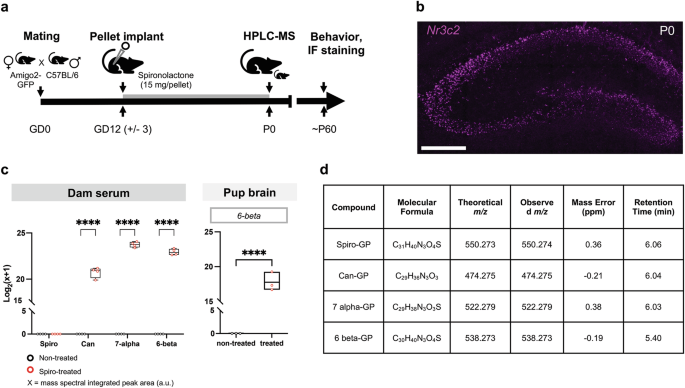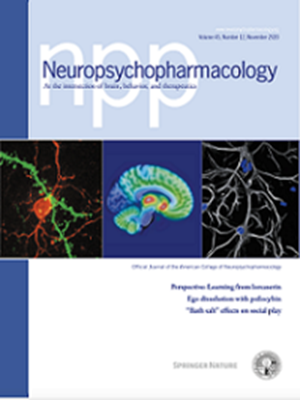产前暴露于矿质皮质激素受体拮抗剂螺内酯会破坏小鼠海马CA2区的连接并改变其行为。
IF 6.6
1区 医学
Q1 NEUROSCIENCES
引用次数: 0
摘要
在啮齿类动物的大脑中,海马富含矿质皮质激素受体(MR;Nr3c2),这是一种受应激激素皮质酮刺激的配体依赖性转录因子。最近,我们发现小鼠 CA2 区神经元的许多特征的获得和维持都需要 MR。值得注意的是,我们观察到在胚胎期(而非出生后)MR基因敲除的小鼠CA2中,囊泡谷氨酸转运体2(vGluT2)的免疫荧光被破坏,而vGluT2可能代表了来自泌乳上核(SuM)的传入。为了测试药物干预子宫内 MR 活性是否同样会破坏 CA2 的连接,我们在小鼠妊娠中期将含有 MR 拮抗剂螺内酯的缓释颗粒植入母鼠体内。在确认至少有一种可能的活性代谢物从母鼠血清进入胚胎大脑后,我们发现螺内酯处理导致 CA2 轴突优先投射的 CA1 oriens 层的 CA2 轴突荧光强度显著降低,螺内酯处理的动物 CA2 和齿状回的 vGluT2 染色显著降低。我们还发现,螺内酯处理的动物对新物体的反应性增加,这种效应类似于胚胎或出生后 CA2 靶向 MR 敲除所产生的效应。然而,我们发现不同处理组之间对社会新事物的偏好并无差异。我们推断这些结果表明,要干扰这种社会行为,可能需要持续或更严重地破坏MR功能。不过,这些发现确实表明,MR 信号传导的发育中断会对海马回路和行为产生持续影响。本文章由计算机程序翻译,如有差异,请以英文原文为准。


Prenatal exposure to the mineralocorticoid receptor antagonist spironolactone disrupts hippocampal area CA2 connectivity and alters behavior in mice
In the brain, the hippocampus is enriched with mineralocorticoid receptors (MR; Nr3c2), a ligand-dependent transcription factor stimulated by the stress hormone corticosterone in rodents. Recently, we discovered that MR is required for the acquisition and maintenance of many features of mouse area CA2 neurons. Notably, we observed that immunofluorescence for the vesicular glutamate transporter 2 (vGluT2), likely representing afferents from the supramammillary nucleus (SuM), was disrupted in the embryonic, but not postnatal, MR knockout mouse CA2. To test whether pharmacological perturbation of MR activity in utero similarly disrupts CA2 connectivity, we implanted slow-release pellets containing the MR antagonist spironolactone in mouse dams during mid-gestation. After confirming that at least one likely active metabolite crossed from the dams’ serum into the embryonic brains, we found that spironolactone treatment caused a significant reduction of CA2 axon fluorescence intensity in the CA1 stratum oriens, where CA2 axons preferentially project, and that vGluT2 staining was significantly decreased in both CA2 and dentate gyrus in spironolactone-treated animals. We also found that spironolactone-treated animals exhibited increased reactivity to novel objects, an effect similar to what is seen with embryonic or postnatal CA2-targeted MR knockout. However, we found no difference in preference for social novelty between the treatment groups. We infer these results to suggest that persistent or more severe disruptions in MR function may be required to interfere with this type of social behavior. These findings do indicate, though, that developmental disruption in MR signaling can have persistent effects on hippocampal circuitry and behavior.
求助全文
通过发布文献求助,成功后即可免费获取论文全文。
去求助
来源期刊

Neuropsychopharmacology
医学-精神病学
CiteScore
15.00
自引率
2.60%
发文量
240
审稿时长
2 months
期刊介绍:
Neuropsychopharmacology is a reputable international scientific journal that serves as the official publication of the American College of Neuropsychopharmacology (ACNP). The journal's primary focus is on research that enhances our knowledge of the brain and behavior, with a particular emphasis on the molecular, cellular, physiological, and psychological aspects of substances that affect the central nervous system (CNS). It also aims to identify new molecular targets for the development of future drugs.
The journal prioritizes original research reports, but it also welcomes mini-reviews and perspectives, which are often solicited by the editorial office. These types of articles provide valuable insights and syntheses of current research trends and future directions in the field of neuroscience and pharmacology.
 求助内容:
求助内容: 应助结果提醒方式:
应助结果提醒方式:


